
Interview with artist, Yuki Shogaki, on drawing animal songs.Please enjoy reading this interview by Imoko Ichinose.
Interview with ar,st Yuki Shogaki, on drawing animal songs
Immersed in sports until getting dark tan lines and playing in a band during the school years
Thank you for taking the time for this interview today. You’re an artist known for drawing animal songs. Have you always been interested in animals, art and music from an early age?
I grew up as the middle child of three siblings, in Minoo city, Osaka. As a child, I was always chasing and joining my older brother in the mountains to play. Perhaps that’s why I’m drawn to trees and nature.
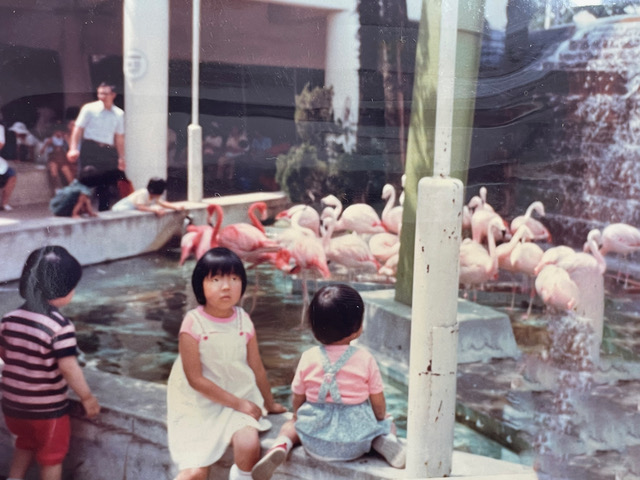
I was a part of the softball team in elementary school, and then moved on to playing tennis in middle school, always sporting a dark tan as a child from various activities.
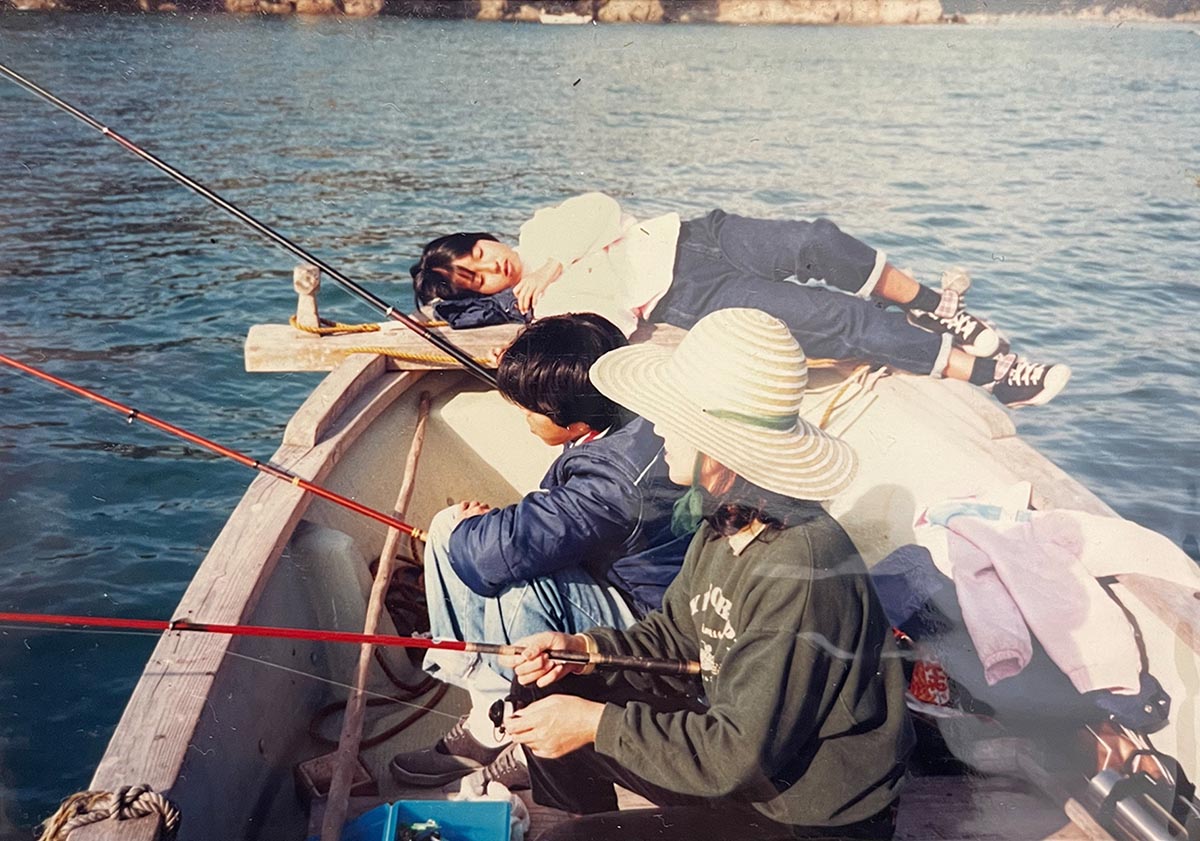
I’ve always liked animals, but not yet that serious about them while young. It was only after having started drawing animals as part of my art that I grew to have a special love for animals.
As a child, I used to paint watercolor in art class, but that was the extent of my drawing and art. I would spend far more time playing outdoors.

I started playing music in high school, forming a copy band with my friends for fun. I remember thinking “I’d like to design the CD jacket when we make our debut”. At the time, I was interested in making scrapbooks cutting out fashion magazines and my friend suggested graphic design as an area of interest for me. That’s when I discovered that such a profession existed, and the reason why I decided to become a designer.
Your hobby as a high schooler suddenly became an inspiration to go into design?
That’s right. I studied illustration for two years at a design school. My dream to design a real CD jacket was the driving force behind my studying art, to ultimately become a graphic designer. It was only then that I truly started to focus on drawing.
At the time, music and my band had an influence on the type of drawings I did. I was very much into drawing portraits of band groups in full costume gear, completely different from what I draw today. Whenever friends from that era see my current art, they often say “This is so different from what you used to do before. Did something happen to bring about this change?”.

How did you make the shift to your signature warm and therapeutic style?
I started working in a design firm and went freelance after staying there for over a decade. Initially, I submitted my drawings to art fairs as a means to get design job offers. It was a sort of challenge for myself. Luckily, I came across entry calls for the “Japan-France Art Market” fair. Inspired by the almost-forgotten Japanese folk songs, I submitted my artwork hoping that it would appeal to foreigners as well as gain domestic interest.
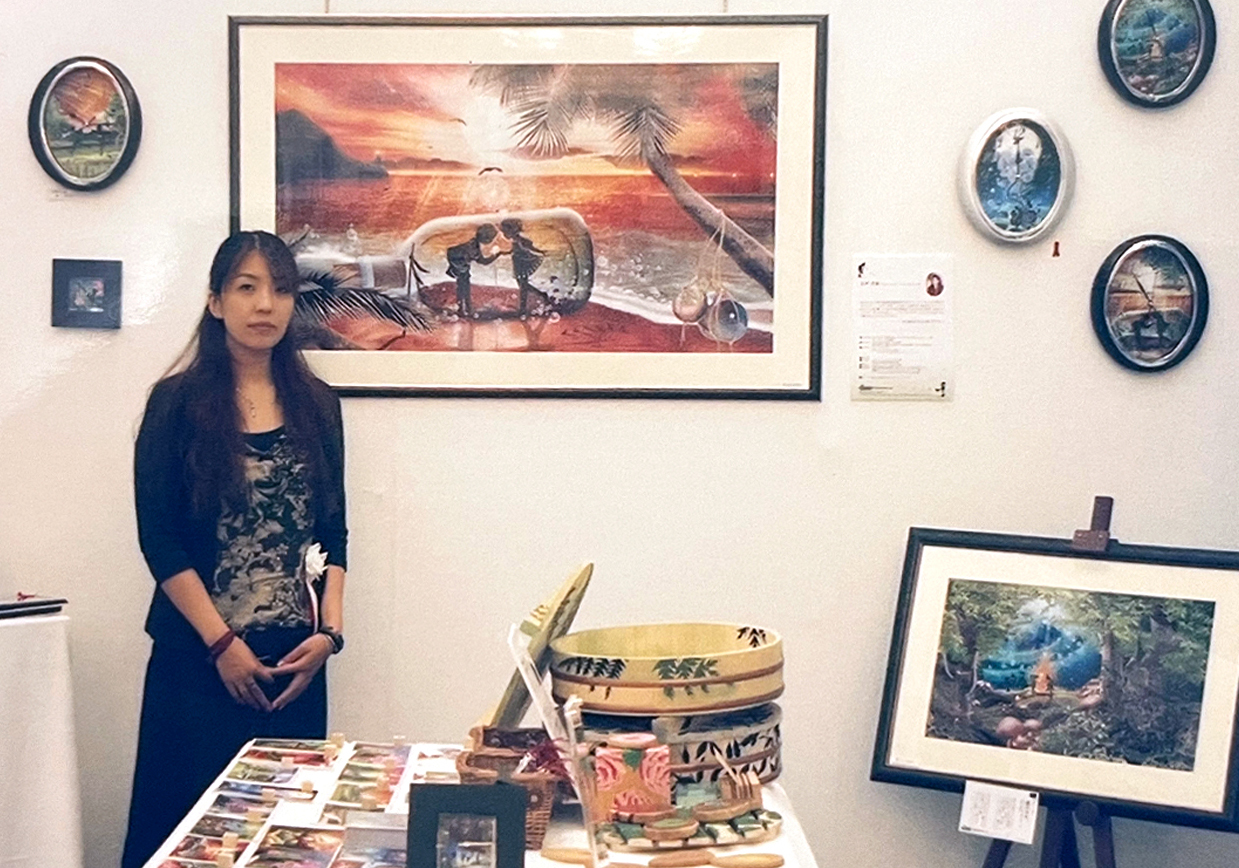

I made this digital artwork based on a Japanese folk song theme. The image in my mind was of a mother singing and telling stories to her child. “Tombo no Megane” (Dragonfly’s Glasses) was inspired by recollections of my older brother and I chasing dragonflies, where we would point and draw circles in the air to play with them. Memories of family outings to see the foliage mixed in with elements of imagination are all inspirations for my artwork. I think these are what helped form my signature art style.
I want my drawings to help those seek solace during sickness
You were approached at the first art fair and commissioned to
make artwork.
I was approached by a person who commented, “your painting is wonderful, may we hang your art at our place?” It turns out they wanted to air my digital art on a monitor in their hospital waiting room. The TV monitor would be airing various medias including hospital notices, local weather forecasts in addition to art. They mentioned wanting to create a segment of “therapeutic art” and asked if they can incorporate my work sensing that it provided a calming effect.

To be honest, I was skeptical of whether someone going through sickness would be willing to look at art. Then, I was told that my art was being aired at various hospitals, which led me to feel that “if my art can be of help to those going through sickness, I want to draw more to help those in need”, and ultimately to “I want my drawings to help those seek solace during sickness”. Soon after, my focus was creating art solely to help those suffering from sicknesses.
What led you to change the way you think about your art?
My cancer diagnosis was the catalyst for the change in thought. In Japan, cancer is so prevalent that it’s viewed as a national disease, but it was a devastating shock to discover my own condition. I spent time being hospitalized, during which I couldn’t make art.
One day out of the blue, my husband got me a dog! Perhaps I seemed bored. Up until then, I’d been drawing and really liked animals, so I was thrilled. From that point, I spent all of my solo time together with my dog. At times, even being ‘forced’ and begged to go for walks.
Dogs depend on you, and it made me feel good to be “depended on” by my dog, even when I was feeling down with my sickness. It gave me confidence and I felt stronger for it.

Animals speak to you, not in a literal sense, but when you spend time with them every day, you sense that they’re trying to tell me something. I sometimes can’t help but wonder if they’re telling me “I’m thirsty! Come look at me and give me cuddles so that I’ll feel safe and drink lots of water!” It might be the band player in me that listens to dogs and hears music instead of barks. Back then, I used to write melody to the lyrics, but now I find myself adding art to lyrics.
Before I was sick, I used to think solely about making patients feel more hopeful and happier, but now I’m drawing for myself as well. Artists who knew me from before mention how my work has shifted to a happier more cheerful tone. Nowadays, I feel that I’m able to enjoy creating my drawings without dwelling too much on sicknesses.

digital giclée print, 13.5 x 13.5cm (limited 10 copies).
Moon Harp
From somewhere afar where the light glows
I hear a gentle sound
Listening with my long ears perked up
Drawn to the sound
I found myself swaying along
Warm and snug sound and light
Reminiscent of my mother’s lullaby
Your being diagnosed with cancer let you to draw for yourself as well as for others. At what moments do you hear the animal songs from your work?
I can tell you about an example using crows. When I watch them outside around my house, they’re hop-walking on the wires. After a while, I would catch one missing his footing and ‘slip’ during one of his hops. That’s when I would hear a song, like “I like sparkly things. Decorating with sparkly flashy knick-knacks. Even my eyes are gems. Hopping and skipping, I was blinded by the light and missed my footing. I’m going to hop and jump again and go look for something sparkly”.
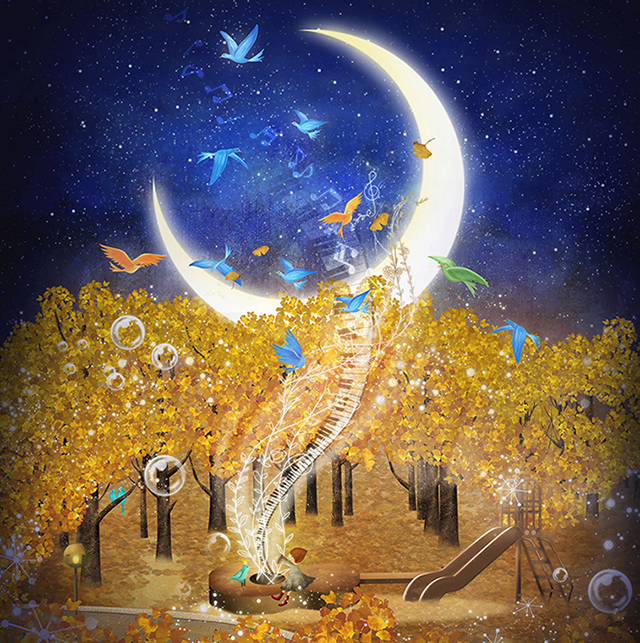
digital giclée print, 13.5 x 13.5cm (limited 25 copies).
Long Autumn Evenings
Torimenotori was bored of long autumn evenings
Hurrying home before darkness fell
He met a charming dwarf
The charming dwarf carried the moon
Torimenotori traded his persimmon for the moon
Then tossed the moon up on the tree
The moon lit up the surrounding
Friends came to gather around
All enjoyed the long autumn evening together
My previous drawings were not that of animal songs, but rather landscapes to draw and invite people “to come here and gather by, you can seek comfort with us and forget your woes”. After I became sick and found my dog partner, I naturally sought to listen to the songs of nature and animals.

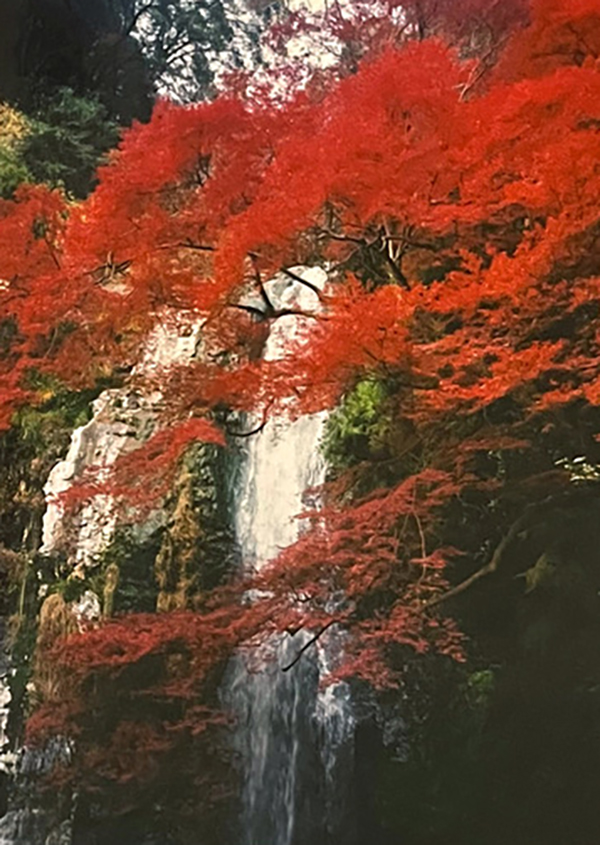
I understand your art style naturally evolved over time.
Once I went freelance and started accepting commissions from hospitals, that period lasted for 20 years. For a long time, my art was solely for the hospital patients. After being diagnosed myself, there was a long stretch when I couldn’t bring myself to draw again.
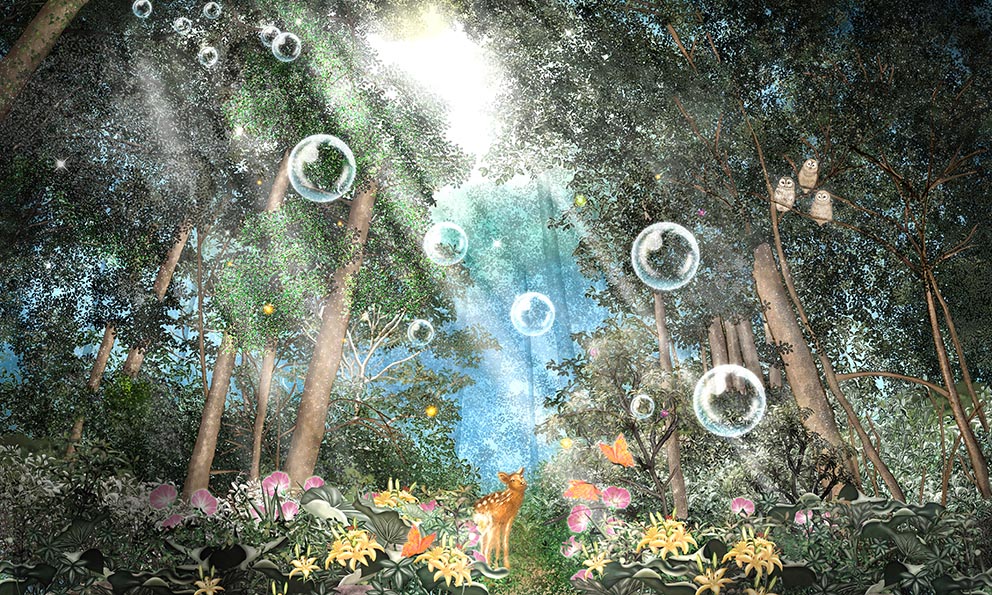
Beauties of Nature
Trees swaying, wind in the flowers, trees stirring
Looking up at the same night sky
What am I thinking?
The flowers, birds, the wind and the moon
Asleep dreaming in the night
I feel certain, that I am alive
Until the sky vanishes
What beautiful moonlight, how tender
When I got my diagnosis, my solo exhibition had been scheduled a few months later. They kindly allowed me to postpone it for a year, and I continued to draw while visiting the hospital for treatments.
Even though my art was initially to “help others during their sickness”, I realized through my own experiences being sick that my art was helping me. When I started feeling better, I began to perceive my work in a more positive way. Eventually, I got to the stage where I’m now able to think that “I draw, because I enjoy it”. Looking back, I recognize I’ve long continued to do work that helps me “live”.
Thank you very much. I look forward to seeing how your activities as an artist will continue to evolve.
(interviewer ・ written by Imoko Ichinose)
Artist: Yuki Shogaki
Yuki Shogaki’s Artist Exhibitions and Awards
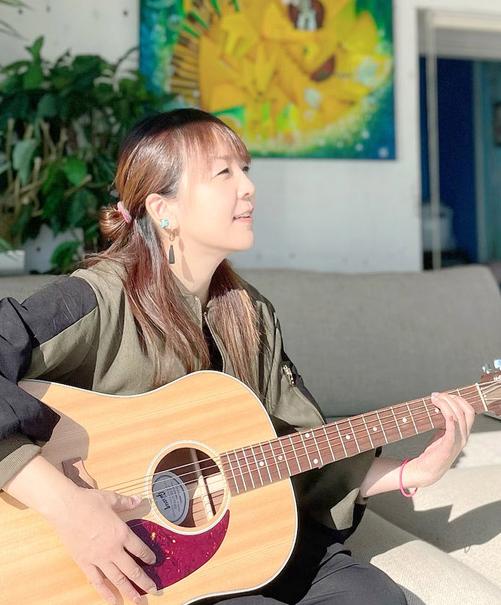
Yuki Shogaki’s Artist Exhibitions and Awards
Exhibitions
2004 Solo exhibition Kobe
2005 Solo exhibition Himeji
2009 Solo exhibition Osaka
2016 Solo exhibition San-yo Department Store / Himeji
2012 Solo exhibition Takatsuki Hankyu / Osaka
2023 Duo exhibition Kintetsu Department Store, Kashihara / Nara
2024 Solo exhibition Isetan Urawa Store / Saitama
Others
Awards
2004 Japan Cotton Promotion Institute Excellence Award for Illustrations
2018 Japan Post Bank Kansai Region Calendar Illustration Machiomoi Book
2021 Nishi Yodogawa Art Terminal Canvas Challenge Grand Prize
Description of Yuki Shogaki’s work “Kuon no Mori” (Forest of Kuon)
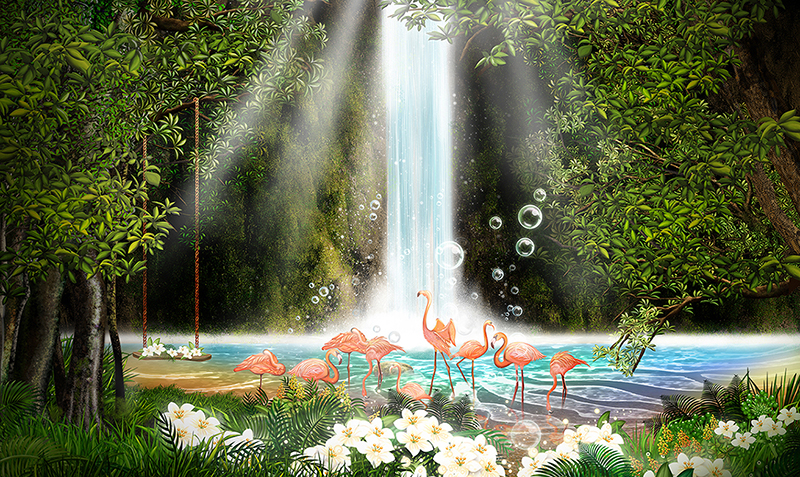
giclee, 32.6 x 54.2cm (limited 10 copies).
The Forest of Kuon
Deep, deep in the forest
There is said to be a waterfall of the elixir of life
Amidst the clearest of air and negative ions
Taking the deepest of breaths, filling your body
You feel alive
Today, the flamingos take their turn
Come, gather here
To nourish yourself
This piece was originally created for the hospital patients. The artist says of this piece, “I wanted to draw this incredibly special place, where no one’s ever been or seen, the beautiful nature of Kuon. I tried to imagine how such a place would be and drew sketches upon sketches”.
Animals gather beside the everlasting waterfall, singing their songs of life. A lone swing gives hope that humans can come visit.
The ‘Kuon” in the forest of Kuon symbolizes eternity, or distant past. The waterfall, signifying the origin of life, is reminiscent of the magnificent Minoo Fall near the artist’s hometown. This piece of art draws its source from the artist’s childhood memories and gives strength and hope for patients to get better.
(description of work by FFD)
Details of Yuki Shogaki’s exhibition
Coming soon….